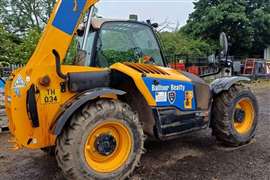Is your scaffold load path safe?
29 July 2024
What is a scaffold load path? The Merriam Webster Dictionary describes a path as a “trodden way.” It also describes a path as a “track specially constructed for a particular use” and “a way of life, conduct or thought.” There is also a towpath and a psychopath, but then perhaps we are wandering off the beaten path.
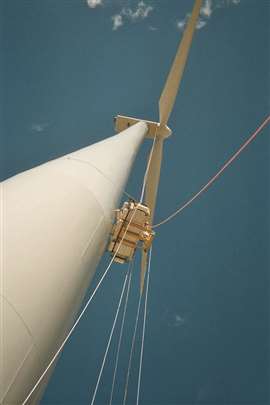 A load path analysis is a method that engineers use in the design of structures. It is applicable to any structure including scaffolds, whether the scaffold is supported, suspended or even a mobile elevated work platform (Photo: David Glabe)
A load path analysis is a method that engineers use in the design of structures. It is applicable to any structure including scaffolds, whether the scaffold is supported, suspended or even a mobile elevated work platform (Photo: David Glabe)
When the qualified person designs a scaffold, a load path analysis is used to determine the components that will support and transfer the loads. A load path analysis is a method that engineers use in the design of structures. It is applicable to any structure including scaffolds, whether the scaffold is supported, suspended or even a mobile elevated work platform (MEWP.) In simple terms, a scaffold load path analysis is used to determine the route a load takes to get to the surface that supports the scaffold.
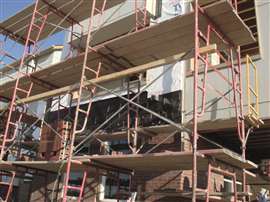 Modifying a scaffold can easily reroute the load path, often with disastrous results. (Photo: David Glabe)
Modifying a scaffold can easily reroute the load path, often with disastrous results. (Photo: David Glabe)
Once the route is determined, the scaffold components that are expected to support the load are identified so it can be verified that these components have the strength to support and transfer the load. If the scaffold components lack the capacity to transfer the load through the scaffold, the scaffold may bend, deflect or collapse. If the structure or building is not strong enough it likewise may bend, deflect or even collapse, none of which is a good outcome.
Assisting designers
As an example, the load path for a two-point suspended scaffold starts with the workers on the suspended platform, travels through the stirrups to the hoist, up the suspension ropes, through the rigging and down to the roof of the building. From there, the load transfers through the building to its foundation where it is distributed through the earth.
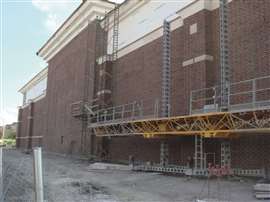 A load path analysis assists the designer in the selection of the right components to handle loads. (Photo: David Glabe)
A load path analysis assists the designer in the selection of the right components to handle loads. (Photo: David Glabe)
A load path analysis assists the designer in the selection of the right components to handle the loads. Once the path is established, the designer can ascertain the strength of each component on this path for sufficient strength since the failure of one component may result in the failure of the entire scaffold, particularly in the case of suspended scaffolds.
It is also important that the load path not be modified without the designer’s approval. For example, suspended scaffolds regularly have a cantilever beam with counterweights to support and transfer the loads from the suspension ropes. Properly installed counterweights will have the correct number of counterweights to balance the cantilever loads. However, if someone borrows a few counterweights, the beam becomes unbalanced, leading to an altered load path.
When too many counterweights are removed, the load path suddenly reroutes into the tieback cable, its anchor to the building, and the building to the ground. If the tieback cable and anchor cannot transfer those loads, they break, and the load path changes again, this time over the side of the building, dramatically increasing the kinetic forces in the platform as it accelerates towards the street below. If the beam, and the attached platform, land on top of the fruit delivery truck on the street, the truck now becomes part of the load path. Suddenly the fruit also becomes part of the load path. The lesson here is to make sure the designed load path remains the load path since fruit does not a good scaffold component make.
For the erectors
Interestingly, it is not common for many scaffold erectors and users to knowingly apply load path analysis when building and using scaffolds. This is particularly true for supported scaffolds where the so-called design is based on experience, visual cues, and keen observation of the scaffold response to applied loads. The typical rule seems to be that if it doesn’t bend too much, it must be okay. Modifying a scaffold can easily reroute the load path, often with disastrous results. Remove the wrong brace, incorrectly reposition a brace, or remove the critical clamp and the pathway to success may suddenly reroute you into the depths of destruction.
It might be concluded that a frame scaffold has a clear and easily discernable load path. That is not necessarily true.
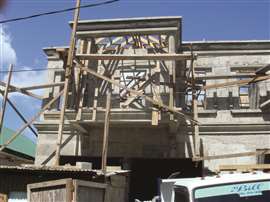 Accident investigations include the use of load paths to assist investigators determine the cause of scaffold failures. A load path analysis will reveal the factors that precipitated the failure by identifying the components which transferred the loads through the scaffold. (Photo: David Glabe)
Accident investigations include the use of load paths to assist investigators determine the cause of scaffold failures. A load path analysis will reveal the factors that precipitated the failure by identifying the components which transferred the loads through the scaffold. (Photo: David Glabe)
Take, for example, the coupling pin that is used to align frame lags when stacking scaffold frames, one on top of another. In such an application, there is no real force on the coupling pin since the load is vertical and transfers directly from the bottom of one tube into the top of the tube below. What happens though, when it is decided to use a crane to lift and relocate a scaffold tower? The erectors cleverly pin the legs with the spring clips and toggle pins that come with the coupling pins. Now, suddenly, the spring clips and toggle pins are being used to transfer the weight of the scaffold from one frame to another, which is directly opposite of what the pins are used for, nor which do they have the strength. A proper load path analysis would have revealed this non-typical use of the pins.
Qualified engineers are not the only ones who can utilize the power of a load path analysis. Whether you are the designer, erector, inspector or user, you too can do a load path analysis. When you look at a worker on a scaffold platform, mentally trace how her weight goes through the scaffold to the supporting surface. Decide which components are being used to transfer that load.
Different means to reach a method
For example, are the bolts that connect the stirrups to the platform of a suspended scaffold the right ones? Are the wire rope clamps of the correct size? Is the roof strong enough? On a system scaffold, are connections tight? Is there adequate diagonal bracing connected at the junction of the horizontal components and legs or are the diagonals installed midway between horizontal members, resulting in excessive horizontal forces on the legs, for which they were not designed? What about that MEWP? How many folks are on the platform? Where is their fall protection anchored to? Has the operator bypassed the safety controls? Likewise, removing bracing from a frame scaffold, for example, alters the capacity of the leg.
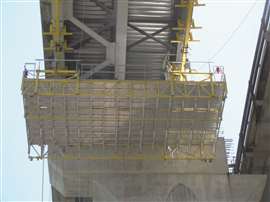 When a qualified person designs a scaffold, suspended scaffold or MEWP, a load path analysis is used to determine the components that will support and transfer the loads. (Photo: David Glabe)
When a qualified person designs a scaffold, suspended scaffold or MEWP, a load path analysis is used to determine the components that will support and transfer the loads. (Photo: David Glabe)
When the leg now overloads, it bends, and the load path is altered. Suddenly, the coupling pin that was designed only for alignment, now is expected to transfer horizontal forces that it cannot do. Undesirable failure ensues.
Accident investigations include the use of load paths to assist investigators determine the cause of scaffold failures. A load path analysis will reveal the factors that precipitated the failure by identifying the components which transferred the loads through the scaffold. Of course, when examining a pile of twisted scaffold debris, the path is easily obscured, resulting in some investigators taking a wrong turn in the path and arriving at the wrong conclusion regarding the mode of failure.
Knowing the path you are on will guarantee you will arrive safely at your destination. Staying on the straight and narrow isn’t such a bad thing after all.
About the author: David Glabe is the founder of DH Glabe & Associates. He is also actively involved in the Scaffold & Access Industry Association and serves as a member on the ANSI A10.8 subcommittee for scaffolding.




